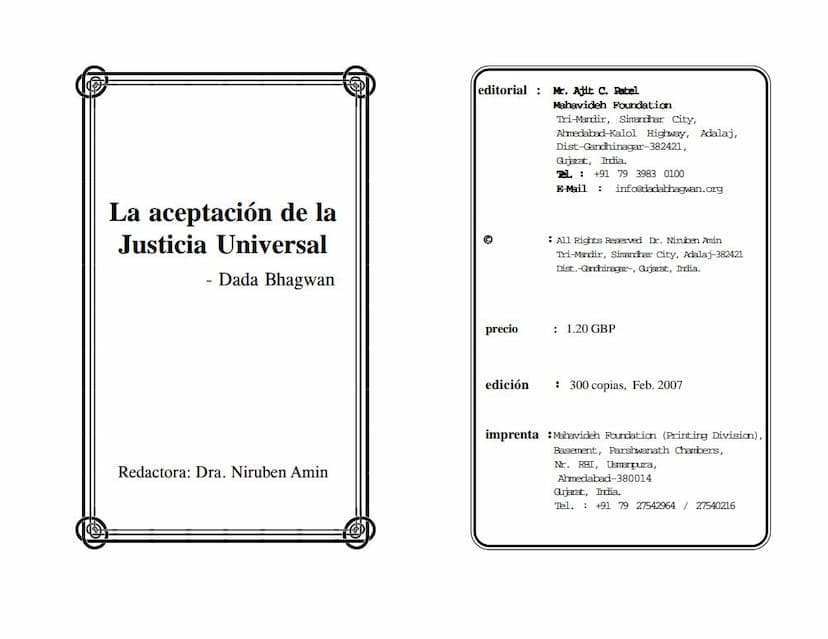Lo Que Ha Sucedido Es Justicia In Spanish Language
Added to library: September 2, 2025

Summary
Here's a comprehensive summary of the Jain text "Lo Que Ha Sucedido Es Justicia" (Whatever Happened is Justice) by Dada Bhagwan, based on the provided pages:
Core Message: Universal Justice and the Dissolution of the Intellect
The central thesis of this book, as expounded by Dada Bhagwan, is that "Whatever happened is justice." This is presented not as a statement to justify injustice but as a profound, scientific understanding of the universe's inherent fairness. The book argues that the root of all suffering and conflict stems from our intellect's demand for human-defined justice and its inability to grasp the true, unfailing justice of nature.
Dada Bhagwan and Akram Vignan:
The text introduces Dada Bhagwan as the Self-Realized Being (Gnani Purush) within Ambalal Muljibhai Patel, who attained Self-Realization spontaneously in 1958. Dada Bhagwan represents the fully manifested inner Self, present in all beings but fully realized within him. He founded Akram Vignan, a shortcut to spiritual liberation described as a "quick elevator path," contrasting with the gradual, step-by-step traditional path (Kram). This path is facilitated by a scientific process called Gnan Vidhi, which can impart Self-Knowledge in a short time.
The Nature of Universal Justice:
- Nature is Always Just: The book emphatically states that nature is always fair, never deviating even for a fraction of a second. Human laws and justice systems can be flawed, but nature's justice is absolute and unfailing.
- Karma and Accounts: All events, both positive and negative, are the result of past karmic accounts. Nothing happens without a reason or a prior account to be settled. Even a mosquito bite occurs only if there's a karmic debt.
- No Injustice in Nature: What appears as injustice to us is, from nature's perspective, a perfectly balanced settling of accounts. When someone experiences loss, suffering, or misfortune, it is a just consequence of their past actions.
- The Role of the Intellect: Our intellect, driven by a desire for worldly justice and personal gain, misinterprets natural justice. It creates questions, doubts, and suffering when events don't align with its expectations. The intellect is the primary obstacle to experiencing peace and liberation.
- Projection, Not Reaction: All experiences are described as one's "own projection." Blaming others or circumstances is a misunderstanding. We are responsible for our reality, and the events we face are the results of our own inner tendencies (bhaavs).
Practical Application and Liberation:
- Acceptance is Key: The path to liberation and inner peace lies in accepting that "Whatever happened is justice." This acceptance dissolves the intellect's grip and brings harmony.
- Non-Interference: By understanding universal justice, one learns not to interfere with the unfolding of events or to try and impose one's own idea of justice. This non-interference is crucial for maintaining inner peace and freedom.
- Observing and Knowing: Instead of questioning or demanding justice, one should simply observe what happens and know it as justice. This detachment prevents suffering.
- The End of Questions: The pursuit of justice fuels the intellect and creates endless questions. By accepting "Whatever happened is justice," all questions cease, leading to liberation.
- Practicality over Theory: The book emphasizes the practical application of this knowledge over theoretical spiritual concepts. "Whatever happened is justice" is presented as a practical sutra for daily life.
- Business and Spirituality: The text also touches upon the idea that spirituality should be integrated into business, not separated from it. Dada Bhagwan himself lived by this principle, never using business profits for personal gain.
Examples and Illustrations:
The book uses various examples to illustrate its points, including:
- An avalanche killing pilgrims, explained as those destined to die meeting their end collectively.
- Family disputes over inheritance, where unequal distribution is presented as a natural settling of past debts.
- A person being run over by a bus, seen as the settling of a karmic account, not due to the driver's fault alone.
- A merchant mistakenly returning less change, explained as a result of past accounts and the inner avarice of the buyer.
- Criticism, accusations, and even natural disasters like droughts and earthquakes are all framed as manifestations of natural justice.
The Goal:
The ultimate goal is to dissolve the intellect by ceasing to seek worldly justice. By accepting the absolute fairness of nature and realizing that "Whatever happened is justice," one can achieve freedom from suffering, tension, and the endless cycle of questions, thereby attaining liberation. The text also highlights that a living Gnani is essential to impart this profound knowledge, as it cannot be fully grasped from books alone.